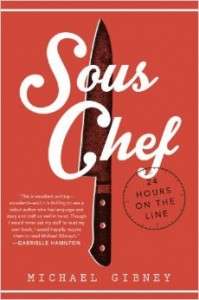Sous Chef: 24 Hours on the Line
Michael Gibney
Ballantine Books
Release Date: April 3, 2014
ISBN 978-0-8041-7788-7
I recently read an article on FirstWeFeast.com, where some of the country’s finest chefs were asked to name what they thought were the most influential restaurants in the United States today. Although I probably will never make it through the doors of any establishment claiming even a single Michelin star, I was interested because: 1) a handful of the chefs voicing opinions were from my hometown, so I was curious as to what they had to say; 2) I watch a few cooking shows on television and have read a couple of chef-related memoirs (Talking With My Mouth Full by Gail Simmons, Yes, Chef by Marcus Samuelsson) as well as a few cooking related novels (the most recent being That Part Was True by Deborah McKinlay), and; 3) I had a few pages left to read in Michael Gibney’s new book, Sous Chef: 24 Hours on the Line and was deep into vicariously immersing myself in the back rooms of the fine dining world.
So I was amazed and thrilled to find that Mr. Gibney’s resume included quite a few those influential restaurants named in the First We Feast article: Alinea, Eleven Madison Park, wd~50, Momofuku. This bit of information gave extra ballast to the sense that I had just read an incredibly gripping, superbly written and utterly authentic work of literature.
The book has a pretty simple premise: show a bird’s eye view of what it takes to be a sous chef in a Big Apple fine dining establishment for 24 hours. For those who may not know (I didn’t!) the sous chef is the second in command of a commercial kitchen, just below the head chef. A sous chef is charged with executing the chef’s vision while ensuring the quality of the overall food output, acting as a supervisor of personnel, being a purveyor of supplies, a liaison with front of house staff and someone who can jump in at any point at any station as the need arises. Knowing this intellectually is one thing – “experiencing” it is quite something else again.
Gruelingly long hours, incredible pressure to perform, meeting inhuman expectations, reveling in artistic expression, dealing with the mundane and sublime, handling conflict, problem solving in any number of arenas, holding on to the highest of standards…. reading this book made me wonder how anyone could be absolutely insane enough to not only feel compelled to but actually enjoy working in the kitchen of a fine dining establishment. It was illuminating and fascinating. And exhausting!
The book doesn’t just walk through the experience – it embraces it. Not only does the reader get detailed and loving insight into the various workstations in the kitchen, the roles of the personnel at the stations, the preparation that goes into maintaining the station as well as the expectations of what is to come from it, but Gibney gives us bright and robust personalities, and a touchingly personal storyline to go along with the restaurant experience. Thanks to this being literature rather than memoir, he can offer unfiltered language, drama and conflict without fear of libel. Because he is writing “fiction”, it can be assumed that he is able to be unabashedly honest in showing not only the glory of working in a well-run kitchen but also how quickly things can go to hell in a handbasket if someone doesn’t pull their weight, if someone’s head gets too big or loses concentration, or if circumstances beyond anyone’s control can’t be overcome.
Also because this is authoritative fiction rather than memoir, there is no need for the author to put disclaiming exposition in the narrative or sidestep the grainier aspects of the tale, but instead lets the characters set the situations and take the book from mere schematic or documentary to vibrant, unapologetic storytelling: kitchen personnel who don’t speak English still get their point across, no translation needed; the less formal the situation, the more “colorful” the language; we glimpse not only the kitchen, but also what happens outside the kitchen, which can be as gritty and real as life in the kitchen is insulated and compartmentalized.
December has done something ugly to the Village. A crust of salt cakes the pavement; slush mucks up gutters; cars and trucks splash winter’s dirty porridge from potholes as they pass. People, bundled up like sausages, slip and shimmy in galoshes across frozen sidewalks up and down Sixth Avenue. You can see them from your perch, fifty paces down the alleylike side street. They don’t notice you, but you notice them. They are getting off work, getting ready to start their weekends. Some of them are on their way out to eat or to a bar for happy hour. Others rush to the train station, on their way out of town for a couple of days to go skiing. Still others are tourists, just visiting for the weekend. They’re here to Christmas shop. They’re here to see the tree at Rock Center. They’re suspiciously rosy-cheeked and healthy looking despite the wintry weather. It’s been years since you’ve had anything that resembles a vacation. You look down at your grayish naked arms. You look up and down the block. There are other cooks and chefs tucked in clusters here and there, resting on other curbs and fire hydrants, in the shadows of other back doors,. Their houndstooth pants give them away. They too, are pale and smoking, – chain-smoking, trying to suck down as many as they can before service starts. They, too, observe the passersby. None of the passersby seem to notice any of them either.
I love that this book is set in second person narrative. (“You knew when you woke up that it was going to be busy. It’s Friday night. This is your reality.”) Some folks have difficulty with this POV, but I found that it immediately assumed an intimacy that allowed author Gibney to jump right into action without having to spend a lot of time establishing a backstory or relationship with the reader. While he does take a lot of time to survey the kitchen and make comments on it, he is able to write flowingly without having to explain every piece of equipment or every type of technique – but it’s good to note that there is a very extensive glossary at the end of the book for those like me who have no idea what a plancha is, or what a cartouche is used for.
Not that I’ll ever use a plancha or a cartouche. This is not a how-to book, nor one that is meant to promote a vocation nor attempt to catapult someone into being a household name. But I can guarantee that, after reading Sous Chef: 24 Hours on the Line, whether you dine at Eleven Madison Park or grab a burger and a beer at your neighborhood Applebee’s, you’ll never take what goes on in the kitchen for granted again.


1 comment
I really like the storyline of this book, sounds like a wonderful read, so interesting.
Comments are closed.